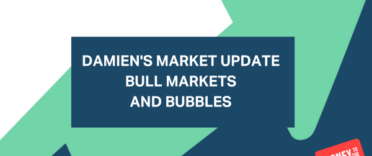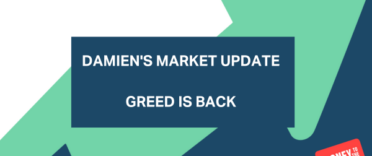Welcome to the latest episode of my monthly YouTube show where I discuss what is happening in investment markets and what to look out for. This episode I talk about the optimism in equity markets, the actions of central banks, the shift in market psychology towards extreme greed as well as the potential risks of complacency in the current market environment.
Each show lasts between 5-10 minutes and is aimed at DIY investors (including novices) seeking contemporary analysis to help them understand how investment markets work.
Subscribe to my YouTube channel to receive my weekly analysis of investment markets or alternatively, you can listen via my weekly Midweek Markets podcast below.
Damien's Market Updates monthly podcast
Other ways to watch, listen and subscribe
You can listen to other episodes and subscribe to the show by searching 'Money to the Masses' on Spotify or by using the following links:
Abridged transcript - Damien's Market Update - June 2023
So a lot has happened since my last market update. Of course, the biggest story was the US debt ceiling. Ahead of the key June deadline, when the US government was supposedly going to be unable to pay the interest on its debts or have sufficient funds to function properly, bond markets remained cautious, even if equity markets were far more optimistic that disaster would be averted.
Ultimately a deal in Congress was struck and talk of the US debt ceiling has been kicked down the road for another 2 years. So panic over. As mentioned, equity investors remained steadfast in their optimism throughout May, confident that a resolution would materialise. This sentiment was reflected in the stock market returns for the month, with the Nikkei 225 showing remarkable strength driven by yen weakness against the US dollar, while the Nasdaq 100 soared higher on the back of investor enthusiasm for Artificial Intelligence (AI) stocks, with Nvidia leading the charge.
With the US debt ceiling crisis in the rearview mirror, investors breathed a collective sigh of relief. At the start of June there were reasons for optimism. The S&P 500 had already surged nearly 12% in 2023 by that point, demonstrating considerable strength. Interestingly, historical data suggests that since 1950, when the S&P 500 has posted gains of at least 8% after the first 100 trading days of a calendar year, the index has averaged an additional 10% gain for the remainder of the year.
In my recent videos, I have highlighted the outperformance of European equities and their significance as drivers of portfolio returns. Notably, the German DAX entered a new bull market in February, having surged 20% from its recent low. Now, the S&P 500 has finally achieved the same milestone.
Despite the optimism, during the first two weeks of June market participants eagerly awaited the next moves from central banks as well as the latest inflation data for their domestic economies.
In summary, this week we’ve seen the US Federal Reserve pull off what is being called a “hawkish pause”. Essentially deciding to not raise interest rates after the US annual inflation rate as measured by CPI fell to 4% in May, which is the slowest since March 2021 and half of the UK’s current inflation rate of 8.7%. But the associated projections from the Fed suggest that two more 0.25% hikes are to be expected this year. So the message was that the Fed would pause for now but would continue hiking later.
Meanwhile, the European Central Bank (ECB) raised its interest rate by 0.25% once again and like the Fed left the door open to more rate hikes, as soon as next month. But investment markets had already begun pricing in that central banks may need to hike interest rates more aggressively than previously anticipated. In fact, the market began betting, even before this week’s Fed announcement, that the Federal Reserve would be compelled to raise interest rates again by July. But the real pain is being felt, in the UK with the BOE now expected to raise the base rate to approximately 5.75% by year-end, up from the current 4.5% level. These expectations have exerted upward pressure on bond yields, especially in the UK where gilt yields have surpassed levels seen in the aftermath of the ill-fated mini-budget and caused chaos in the mortgage market.
The Bank of England (BOE) is due to meet next week to decide its latest policy position and is expected to raise its base rate by at least 0.25%. The BOE finds itself in a tough spot right now. But if you want to get a sense of investment markets right now you can look at the CNN Fear & Greed Index. Just a month ago, the Fear and Greed Index stood at a relatively modest 58, reflecting a balanced sentiment. However, we've witnessed a rapid shift in market psychology as a result of the recent equity rally, with the index now indicating extreme greed. The lack of fear is also present in the CBOE Volatility Index (VIX), which is a measure of expected stock market volatility and is often referred to as the US stock market's "fear gauge". This week the VIX fell to its lowest level since February 2020.
With the S&P 500 now in a new technical bull market alongside similar stock market optimism elsewhere (particularly in Europe), the fear of missing out (FOMO) is driving markets right now. Bank of America recently published research that showed that the "buy the dip" mantra is on for its 3rd best year on record. We even saw investors buy the dip after the hawkish surprise following the Fed announcement this week. Investors have seemingly put 2022 behind them when buying every stock market dip was punished. 2023 is now very different.
Another reason for optimism is that we’ve also seen significant breadth improvement in US stocks meaning that other equity sectors have begun to outperform tech stocks, helping to push the wider market higher. US small caps have also outperformed tech stocks at times in the last few weeks as money flows back into regional US banks that have been market laggards since the banking sector wobble in March. The current positive signs of breadth suggest that sector rotations are taking place, which is generally considered a healthy characteristic of a bull market.
But often with extreme greed and lack of fear comes complacency and overconfidence. Concerns remain that the US government's impending borrowing spree, following the resolution of the debt ceiling fight, could put renewed strain on the US banking system. Could the banking crisis be about to make a return? Also, the last time the fear and greed index hit these levels was at the short-term market high at the start of February this year, before the market pulled back. Meanwhile the VIX has hit lows we’ve not seen since February 2020. That happened to be just days before the fastest bear market in history unfolded thanks to the pandemic.
In conclusion, the current market environment reflects a mix of extreme greed, optimism, and complacency. While sector rotations and improved breadth are positive indicators, investors should remember that markets eventually have a nasty way of humbling even the most confident of investors. Don’t be surprised if things pause or pullback as markets can’t go up forever but those who have been betting against the equity market of late have been left licking their wounds.



